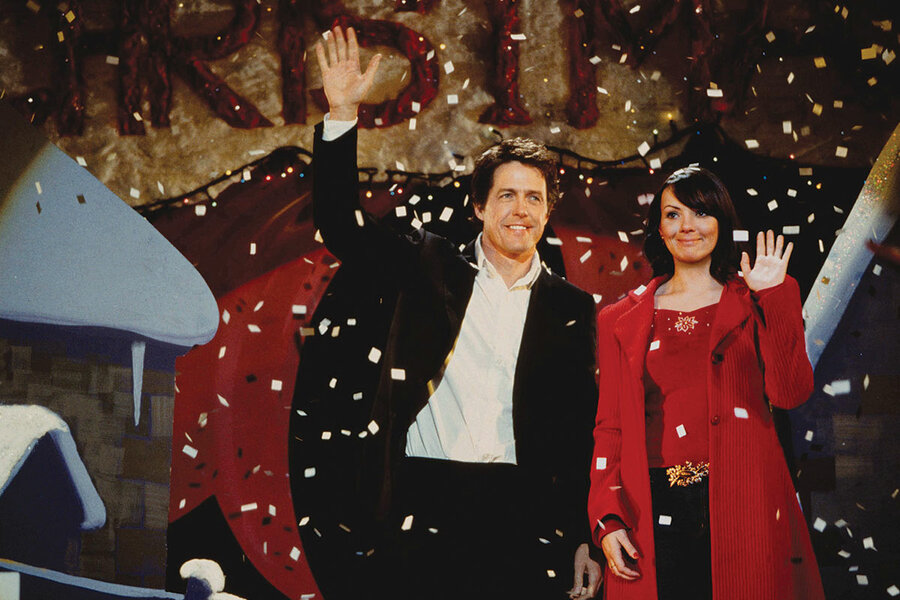They can’t all be Scrooge: How holiday films shine
Loading...
Twenty years ago, a pair of Christmas movies made cash registers ring like jingle bells. In “Elf,” a human raised by elves searches for his father in New York City. “Love Actually” came out a week later. The British megahit features a patchwork of heartwarming, tragic, and raunchy storylines.
Those two films are credited with reinvigorating the Christmas movie genre. The recipe looks simple. Take one grumpy old soul crying out for redemption, possibly supernaturally aided. Sprinkle in holiday songs and sleigh bells. And budget for plenty of fake snow.
Why We Wrote This
A story focused onAs two Christmas classics turn 20, we’re reminded of the genre’s true gifts. More than making you laugh or cry, good holiday films often reinforce that life has meaning.
Yet for every occasional treat in the 21st century – including “The Holiday” and “Klaus” – many more turn out about as well as a homemade Christmas sweater. Too often, holiday movies forget the most important ingredients. Great Christmas stories tap into a longing for meaning in life – that love can actually transform us. That generosity matters. That sincerity might seem hokey in a cynical age, but that innocence has pride of place, especially at Christmas.
“Almost every Christmas movie has some character or characters transforming to better, higher versions of themselves,” says Jeremy Arnold, author of “Christmas in the Movies.” “That speaks to us because it’s the magic that we want Christmas to be.”
Twenty years ago, a pair of Christmas movies made cash registers ring like jingle bells. In “Elf,” a human raised by elves searches for his father in New York City. “Love Actually” came out a week later. The British megahit, nicknamed “Loathe Actually” by its detractors, features a patchwork of heartwarming, tragic, and raunchy Christmas storylines.
Those two films are credited with reinvigorating the Christmas movie genre. The recipe looks simple. Take one grumpy old soul crying out for redemption, possibly supernaturally aided. (If not ghosts, a dog will do.) Sprinkle in beloved holiday songs and sleigh bells. Add at least one embarrassing costume. Oh, and budget for plenty of fake snow.
Yet, for every occasional treat in the 21st century – including “The Holiday,” “Joyeux Noel,” and “Klaus” – many more turn out about as well as a homemade Christmas sweater. Too often, holiday movies forget the most important ingredients. Great Christmas stories tap into a longing for meaning in life – that love can actually transform us. That generosity matters. That sincerity might seem hokey in a cynical age, but that innocence has pride of place, especially at Christmas.
Why We Wrote This
A story focused onAs two Christmas classics turn 20, we’re reminded of the genre’s true gifts. More than making you laugh or cry, good holiday films often reinforce that life has meaning.
“Almost every Christmas movie has some character or characters transforming to better, higher versions of themselves,” says Jeremy Arnold, author of “Christmas in the Movies.” “That speaks to us because it’s the magic that we want Christmas to be.”
The “Christmas Carol” effect
The spirit of Ebenezer Scrooge looms over Christmas movies past, present, and yet to come. Charles Dickens pretty much invented the fictional genre with “A Christmas Carol,” and his protagonist has been embodied by dozens of actors – notably Alastair Sim, Patrick Stewart, George C. Scott, and Michael Caine – and a Disney cartoon duck. Some variations of the tale, such as the 1988 Bill Murray vehicle “Scrooged,” critique materialism.
“In a lot of our Christmas comedies, we see there is a built-in cynicism about our consumer culture and about how what was initially conceived of as a religious holiday has become a marketing bonanza and an occasion for getting stuff,” says film critic Ty Burr.
Countless other stories have modeled characters on Dickens’ iconic misanthrope, albeit without the Victorian sleeping cap. For instance, Alexander Payne’s new movie, “The Holdovers,” stars Paul Giamatti as a Scrooge-like boarding school teacher who is tasked with chaperoning a lonely student over the Christmas break. Dr. Seuss’ “How the Grinch Stole Christmas!” (first adapted as an animated short and, later, a live-action film) features an avocado-shaped creature whose heart is two sizes too small. And in “One Magic Christmas” (1985), a rancorous suburban housewife (Mary Steenburgen) meets an unconventional angel (Harry Dean Stanton).
“He kills off her husband and children in a car crash and then brings them back [just] in time so that she can understand the true meaning of Christmas,” says Mr. Burr, author of “The Best Old Movies for Families.” “Believe it or not, the movie works. But boy, does it get dark. And it’s a Disney movie on top of everything else.”
The dark night of the soul is similarly bleak in Jimmy Stewart’s twin holiday classics, “It’s a Wonderful Life” and “The Shop Around the Corner.” Characters contemplate suicide, job loss, and financial ruin. In those films, human connection displaces the shadows.
The Cold War heightened that desire for security even more, says movie historian Vaughn Joy, who cites “White Christmas” and “It’s a Wonderful Life” as her two favorite holiday movies.
The 1950s were an era when home and the nuclear family were seen as sanctuaries. A number of postwar Christmas movies – including “Holiday Affair,” “Miracle on 34th Street,” and “The Bishop’s Wife” (a 1996 remake starred Whitney Houston) – depicted the family unit as the center of one’s financial and emotional security. “And [it] is made into the ultimate ideal of security and kindness and generosity that just kind of marries very well with Christmas,” Ms. Joy says.
Holiday fare as a way to heal
“It’s a Wonderful Life” director Frank Capra and Stewart both served in World War II and understood the importance of love and family during its aftermath. Indeed, the two greatest eras for Christmas movies came immediately after world-altering tragedies: World War II and 9/11, says Mr. Arnold.
“My argument is that since it takes a year or two to make a movie and get it into theaters, it really can be seen in part as a response to those national traumas,” he continues. “Audiences craved getting back together, being a community again, and sharing in a movie experience, laughing together and so on ... making them feel better and more secure at a time when they weren’t.”
In fact, “Elf” director Jon Favreau, a native New Yorker, saw the movie as an explicit attempt to reclaim New York after the terrorist attacks. He’s spoken about showing the city dressed in its holiday best and about the desire to give its children a reason to hope. (To the dismay of parents, young viewers may have tried to replicate Buddy the Elf’s favorite recipe: spaghetti covered in M&Ms, maple syrup, and chocolate sauce.)
“Love Actually” also was created in reaction to 9/11.
“It starts with that opening monologue by actor Hugh Grant, where he talks about when the messages people sent as the planes were going into the towers,” says Scott Meslow, author of “From Hollywood With Love.” “Even now for me, knowing that that’s coming, it’s still kind of a record scratch. ... We think of these movies in these kind of hazy, feel-good terms, and it’s like, no, it’s explicitly about the immediate post-9/11 political era.”
Director Richard Curtis shot clandestine footage of people reuniting at airports for his film, especially poignant in an era when people were afraid to fly. And his overlapping storylines crammed in as many different kinds of love as he could fit into 2 hours and 15 minutes.
The early 2020s, too, have been a time of bleakness, marred by pandemic and war. Somewhere, writers may be channeling their inner Charlie Browns, searching for the true meaning of the holiday.
In the words of the titular character of “Auntie Mame,” haul out the holly. Because we need a little Christmas now.









